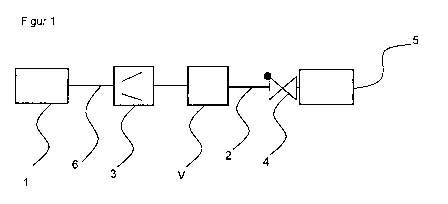Some of the information on this Web page has been provided by external sources. The Government of Canada is not responsible for the accuracy, reliability or currency of the information supplied by external sources. Users wishing to rely upon this information should consult directly with the source of the information. Content provided by external sources is not subject to official languages, privacy and accessibility requirements.
Any discrepancies in the text and image of the Claims and Abstract are due to differing posting times. Text of the Claims and Abstract are posted:
| (12) Patent Application: | (11) CA 2911197 |
|---|---|
| (54) English Title: | METHOD FOR DETERMINING A HYDROGEN TANK PRESSURE |
| (54) French Title: | PROCEDE PERMETTANT DE DETERMINER LA PRESSION D'UN RESERVOIR D'HYDROGENE |
| Status: | Deemed Abandoned and Beyond the Period of Reinstatement - Pending Response to Notice of Disregarded Communication |
| (51) International Patent Classification (IPC): |
|
|---|---|
| (72) Inventors : |
|
| (73) Owners : |
|
| (71) Applicants : |
|
| (74) Agent: | GOWLING WLG (CANADA) LLP |
| (74) Associate agent: | |
| (45) Issued: | |
| (86) PCT Filing Date: | 2014-06-26 |
| (87) Open to Public Inspection: | 2015-01-08 |
| Availability of licence: | N/A |
| Dedicated to the Public: | N/A |
| (25) Language of filing: | English |
| Patent Cooperation Treaty (PCT): | Yes |
|---|---|
| (86) PCT Filing Number: | PCT/EP2014/001735 |
| (87) International Publication Number: | WO 2015000563 |
| (85) National Entry: | 2015-11-02 |
| (30) Application Priority Data: | ||||||
|---|---|---|---|---|---|---|
|
The invention relates to a method for determining a tank pressure (12) in a tank (5) before the tank (5) is filled with pressurised, gaseous hydrogen, according to which method an accumulator (1), in which the hydrogen to be used to fill the tank is stored as liquid hydrogen, is connected to the tank (5) by means of a filling line (2) and a subsequent check valve (4) of the tank (5), wherein hydrogen is pumped from the accumulator (1) into the filling line (2) by means of a pump (3) and the filling-line pressure (11) arising in the filling line (2) during the pumping is measured, wherein the check valve (4) is opened if the filling-line pressure (11) exceeds the tank pressure (12), and wherein the tank pressure (12) is determined as the filling-line pressure (11) that exists when the check valve (4) is opened.
L'invention concerne un procédé permettant de déterminer une pression (12) dans un réservoir (5) avant le remplissage de ce réservoir (5) en hydrogène gazeux sous pression. Selon ce procédé, un accumulateur (1) dans lequel l'hydrogène destiné à être utilisé pour le remplissage est accumulé sous forme d'hydrogène liquide est relié au réservoir (5) par une conduite de remplissage (2) et un clapet anti-retour (4), monté en aval (4), du réservoir (5). L'hydrogène est pompé de l'accumulateur (1) dans la conduite de remplissage (2) au moyen d'une pompe (3) et la pression (11) de la conduite de remplissage se formant ainsi dans la conduite de remplissage (2) est mesurée, le clapet anti-retour (4) étant ouvert lorsque la pression (11) de la conduite de remplissage dépasse la pression (12) du réservoir, et la pression (12) du réservoir étant définie comme la pression (11) de la conduite de remplissage régnant à l'ouverture du clapet anti-retour (4).
Note: Claims are shown in the official language in which they were submitted.
Note: Descriptions are shown in the official language in which they were submitted.

2024-08-01:As part of the Next Generation Patents (NGP) transition, the Canadian Patents Database (CPD) now contains a more detailed Event History, which replicates the Event Log of our new back-office solution.
Please note that "Inactive:" events refers to events no longer in use in our new back-office solution.
For a clearer understanding of the status of the application/patent presented on this page, the site Disclaimer , as well as the definitions for Patent , Event History , Maintenance Fee and Payment History should be consulted.
| Description | Date |
|---|---|
| Application Not Reinstated by Deadline | 2018-06-27 |
| Time Limit for Reversal Expired | 2018-06-27 |
| Change of Address or Method of Correspondence Request Received | 2018-01-10 |
| Deemed Abandoned - Failure to Respond to Maintenance Fee Notice | 2017-06-27 |
| Inactive: Notice - National entry - No RFE | 2015-11-09 |
| Application Received - PCT | 2015-11-09 |
| Inactive: First IPC assigned | 2015-11-09 |
| Inactive: IPC assigned | 2015-11-09 |
| National Entry Requirements Determined Compliant | 2015-11-02 |
| Application Published (Open to Public Inspection) | 2015-01-08 |
| Abandonment Date | Reason | Reinstatement Date |
|---|---|---|
| 2017-06-27 |
The last payment was received on 2016-05-25
Note : If the full payment has not been received on or before the date indicated, a further fee may be required which may be one of the following
Please refer to the CIPO Patent Fees web page to see all current fee amounts.
| Fee Type | Anniversary Year | Due Date | Paid Date |
|---|---|---|---|
| Basic national fee - standard | 2015-11-02 | ||
| MF (application, 2nd anniv.) - standard | 02 | 2016-06-27 | 2016-05-25 |
Note: Records showing the ownership history in alphabetical order.
| Current Owners on Record |
|---|
| LINDE AKTIENGESELLSCHAFT |
| Past Owners on Record |
|---|
| HARALD KRAUS |
| MICHAEL WESTERMEIER |
| TOBIAS KEDERER |
| WILFRIED-HENNING REESE |